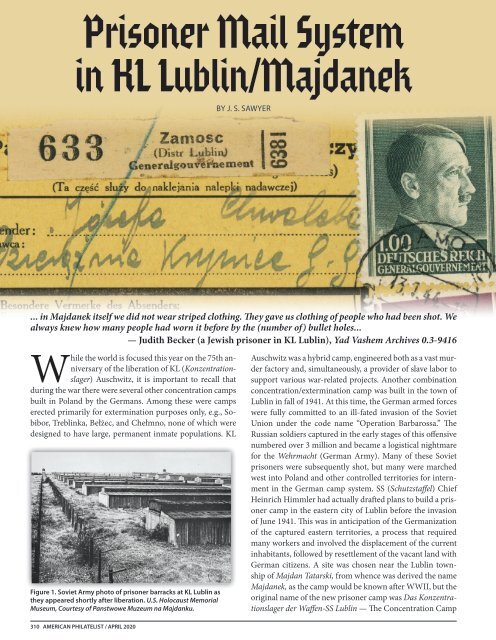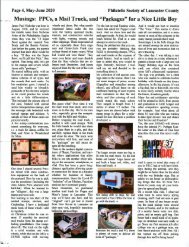The American Philatelist April 2020
Holocaust Rememberance Issue
Holocaust Rememberance Issue
Create successful ePaper yourself
Turn your PDF publications into a flip-book with our unique Google optimized e-Paper software.
Prisoner Mail System<br />
in KL Lublin/Majdanek<br />
BY J. S. SAWYER<br />
... in Majdanek itself we did not wear striped clothing. <strong>The</strong>y gave us clothing of people who had been shot. We<br />
always knew how many people had worn it before by the (number of) bullet holes...<br />
— Judith Becker (a Jewish prisoner in KL Lublin), Yad Vashem Archives 0.3-9416<br />
While the world is focused this year on the 75th anniversary<br />
of the liberation of KL (Konzentrationslager)<br />
Auschwitz, it is important to recall that<br />
during the war there were several other concentration camps<br />
built in Poland by the Germans. Among these were camps<br />
erected primarily for extermination purposes only, e.g., Sobibor,<br />
Treblinka, Bełżec, and Chełmno, none of which were<br />
designed to have large, permanent inmate populations. KL<br />
Figure 1. Soviet Army photo of prisoner barracks at KL Lublin as<br />
they appeared shortly after liberation. U.S. Holocaust Memorial<br />
Museum, Courtesy of Panstwowe Muzeum na Majdanku.<br />
Auschwitz was a hybrid camp, engineered both as a vast murder<br />
factory and, simultaneously, a provider of slave labor to<br />
support various war-related projects. Another combination<br />
concentration/extermination camp was built in the town of<br />
Lublin in fall of 1941. At this time, the German armed forces<br />
were fully committed to an ill-fated invasion of the Soviet<br />
Union under the code name “Operation Barbarossa.” <strong>The</strong><br />
Russian soldiers captured in the early stages of this offensive<br />
numbered over 3 million and became a logistical nightmare<br />
for the Wehrmacht (German Army). Many of these Soviet<br />
prisoners were subsequently shot, but many were marched<br />
west into Poland and other controlled territories for internment<br />
in the German camp system. SS (Schutzstaffel) Chief<br />
Heinrich Himmler had actually drafted plans to build a prisoner<br />
camp in the eastern city of Lublin before the invasion<br />
of June 1941. This was in anticipation of the Germanization<br />
of the captured eastern territories, a process that required<br />
many workers and involved the displacement of the current<br />
inhabitants, followed by resettlement of the vacant land with<br />
German citizens. A site was chosen near the Lublin township<br />
of Majdan Tatarski, from whence was derived the name<br />
Majdanek, as the camp would be known after WWII, but the<br />
original name of the new prisoner camp was Das Konzentrationslager<br />
der Waffen-SS Lublin — <strong>The</strong> Concentration Camp<br />
310 AMERICAN PHILATELIST / APRIL <strong>2020</strong>

















